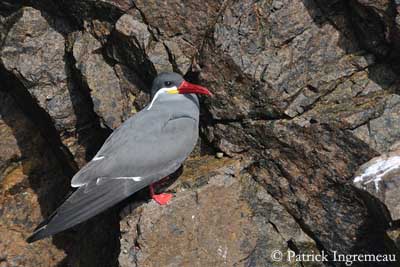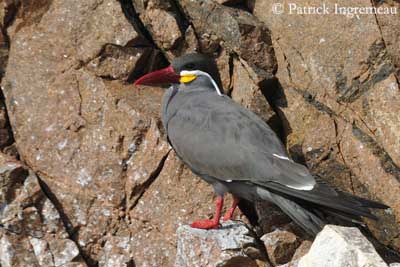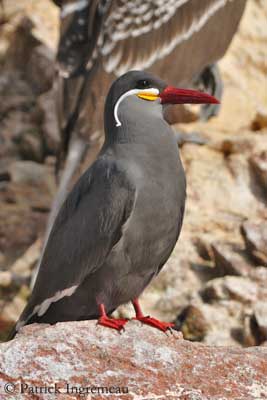
Inca Tern
Larosterna inca
Charadriiforme Order – Laridae Family
BIOMETRICS:
Length: 39-42 cm
Weight: 180-210 g
DESCRIPTION:
Inca Tern is a superb and unique seabird with very peculiar plumage and head pattern, so different from other seabirds.
Due to these differences, the Inca Tern is the only member of the genus “Larosterna”.
Adult has dark slaty-grey plumage overall. The rounded, narrow wings show darker flight feathers and paler grey underwing coverts. The trailing edge is white. The outer primaries are edged white. The inner primaries and secondaries are tipped white. The tail is slightly forked and darker than the body.
The head is superb and strange. Forehead, crown and nape are dark slaty-grey. Starting at the bill base, a white stripe curls back below the eye, and extends downwards to the neck side. The tip is made with long fine feathers which fan out on each side of the head. Below this white stripe, we can see yellow bare skin forming mouth-shaped wattles at bill base.
The throat and the area below the wattles is pale grey.
The strong, long bill is deep red. Eyes are dark brown. Legs and webbed feet are dark red.
Fr : Sterne Inca
All : Inkaseeschwalbe
Esp : Charrán Inca
Ital : Sterna inca
Nd : Inkastern
Photographs by Patrick Ingremeau
TAMANDUA
Text by Nicole Bouglouan
Sources:
HANDBOOK OF THE BIRDS OF THE WORLD Volume 3 by Josep del Hoyo-Andrew Elliott-Jordi Sargatal - Lynx Edicions - ISBN : 8487334202
A GUIDE TO THE BIRDS OF COLOMBIA by Steven L. Hilty and William L. Brown - Princeton University Press – ISBN 069108372X
L’ENCYCLOPEDIE MONDIALE DES OISEAUX - Dr Christopher M. Perrins - BORDAS - ISBN: 2040185607
Institut de l’Information Scientifique et Technique
Wikipedia (Wikipedia, The Free Encyclopedia)
Welcome to WhoZoo (Jill Foley)

Juvenile has blackish plumage, bill and legs. We can see small grey tufts at bill base.
Subadult is browner. The bill turns dark horn-coloured, and becomes redder little by little. It shows some dull brown curling feathers at gape.
VOICE: SOUNDS BY XENO-CANTO
Inca Tern utters cat-like mewing sounds.
HABITAT:
Inca Tern breeds on the coasts with rocky cliffs and sandy beaches. It may frequent as well inshore guano islands as offshore islands along the rocky coasts.
RANGE:
Inca Tern is found on the west coast of South America, from Ecuador and Peru, to Chile.
This bird is endemic to the Humboldt Current area.

BEHAVIOUR:
Inca Tern is gregarious, living and nesting in huge colonies of several thousands of birds, often close to the gulls’ colonies.
They feed on many kinds of marine animals, such as fish (anchovetta) and crustaceans. They also take offal. Inca Tern follows the fishing boats and is often associated with sea lions and whales when feeding, stealing some food from the marine mammals.
This tern feeds by plunge-diving from the air, after brief flight above the prey, and also by surface-dipping. The tern swims or sits on the water and picks-up the preys from the surface.
Inca Tern performs courtship displays. The male engages an agile flight display in order to impress the female. It also performs courtship feeding while pursuing the female in the air, with a fish in the bill. Then, both mates choose the nest-site in sheltered areas, and the pair often returns to the same nest-site year after year.
Inca Tern is resident in its range. Only the non-breeding birds may move according to the food resources.

FLIGHT:
Inca Tern has graceful flight. It soars above the water and dives into the sea for preys.
REPRODUCTION OF THIS SPECIES:
Inca Tern breeds twice a year, between April and July and between October and December.
Inca Tern nests on sandy beaches or guano islands. This tern nests mainly in crevices, fissures, burrows, holes in rocks, at base of rocky cliffs and boulders, in abandoned seabirds’ burrows and even on ledges of human structures.
Inca Tern chooses deep crevices in rocks where there are numerous cavities and good protection by cliffs. The chicks which hatch in deep holes are protected for longer time from predators, whereas the nests distant from the cliffs are more exposed to predation by raptors and larges seabirds.
Female lays 1-3 eggs. Incubation lasts about 3-4 weeks. Both parents incubate and feed the greyish chicks. The young fledge about 4 weeks after hatching, and reach their independence one month later.

DIET:
Inca Tern feeds mainly on small anchovetta (Engraulis ringens) found in the south-eastern Pacific Ocean. It also consumes crustaceans and offal.
PROTECTION / THREATS / STATUS:
Inca Terns’ numbers depend on food resources and strong storms such as El Niño. Populations decline during these severe storms, but they become stable again relatively quickly. Suitable nesting habitat is available and Inca Tern breeds along the South American coasts.
However, this species is considered as NEAR THREATENED.